|
|
|
| |
|
|
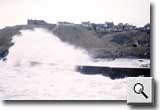 |
| The Pier |
| |
Collieston
viewed from Cransdale in 1957. Waves, fuelled by a
north-easterly wind, are crashing against the Pier
wall. Built in 1894, the Pier had had to endure more
than one hundred years of pounding by the North Sea
and had sustained some damage along the way.
By the late 1950’s the Pier was in a sad state
of repair. Sir Douglas Ritchie, who had recently retired
to the family home in the village, proposed the formation
of a Collieston Amenities Committee. Formed in 1957,
its purpose was to raise money for the maintenance
of the Pier as well as the unique system of roadies
or paths that ran throughout the village.
To the rear are the relatively calm waters of the
protected harbour. Clearly visible on the horizon
behind the crashing waves is the headland known as
the Braehead, a popular vantage point for both locals
and visitors. |
| |
|
|
| |
|
|
| |
Aerial
View |
|
| |
| |
A
southerly view taken circa 1950 which clearly shows
the houses huddled round the harbour in the foreground
and the patchwork fields of the surrounding farmland
to the rear of the village.
Collieston’s first name was appropriately enough
Seatown. Collieston comes from Gaelic and means ‘a
hamlet nestling between the hills’. Legend has
it that when nearby Forvie, to the south of the present
day village, was blown over by a catastrophic sandstorm
in 1413 the survivors found a safe haven of refuge
there.
|
| |
|
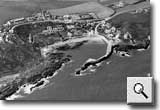 |
| |
|
|
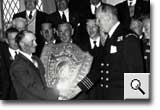 |
| Coastguards |
| |
The Collieston
Auxiliary Coastguard Company was called out to assist
after the drifter ‘Stephens’ ran aground
in bad weather some 200 yards offshore on the Forvie
Sands on November 8, 1956. For their part in the successful
rescue of the ship’s 10-man crew by breeches
buoy, the Company was awarded the Board of Trade Shield
in 1957 for the best wreck service of the year.
|
| |
|
|
| |
|
|
| |
First
Gala Day |
|
| |
| |
Sir
Douglas Ritchie (left) and Richard (Dick) Donald (right),
a resident of the village and Director of Aberdeen
Football Club, are standing in front of a stall and
marquee at the first Gala Day in 1958.
By the mid 1950’s the Pier, built in 1894, was
in a sad state of repair. Sir Douglas Ritchie, from
an old Collieston family and formerly Vice Chairman
of the London Port of Authority, had retired to the
family home in the village and proposed the formation
of a Collieston Amenities Committee.
Formed in 1957, its purpose was to attempt to raise
money for the maintenance of the Pier and the unique
system of roadies or paths that ran throughout the
village. The first Gala Day to raise money for this
conservation task was held in 1958. The Pier was duly
repaired and Gala Day has been a feature of village
life every summer since.
|
| |
|
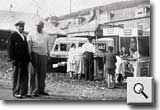 |
| |
|
|
 |
| Food
Factory |
| |
The food
label, incorporating a tartan design, is from one
of the last tins of black pudding to be produced at
Maclean’s Scotch Food Factory in Collieston.
The company, whose registered trade mark was ‘Gillie’,
operated from their factory location in the High Town
area of the village in what was previously the old
stable block of Slains Lodge.
The factory closed in the early 1960’s and the
building was subsequently bought in the early 1980’s
by Barratt Construction who converted it into houses
and renamed it Forvie Court.
|
| |
|
|
| |
|
|
| |
Holiday
Time |
|
| |
| |
A
group of holidaymakers enjoy a picnic on the Pier
on a fine summer’s day in the 1950’s.
The line of the road running from the harbour up to
the village is clearly identifiable as is the row
of cottages, formerly Coastguard Cottages, now private
dwellings.
‘Buckies’, the white house traditionally
built gable-end to the sea, was the village tea-room
for a few years during the 1980’s and proved
to be a popular destination for holiday-makers after
a relaxing day on the beach.
Evidence of the villagers’ involvement in the
smuggling trade during the 18th Century can still
be seen by way of the small window, or ‘smugglers’
windicky’, built under the chimney of ‘Buckies’.
A lamp would have been placed here with the intention
of signalling to a schooner carrying contraband out
in the bay.
|
| |
|
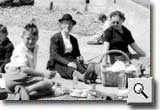 |
| |
|
|
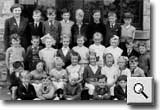 |
| Education |
| |
Teacher
and pupils of Slains School in 1955. The children
who went to Slains School lived in Slains, Auchmacoy
or Collieston. The building, visible behind the children,
was demolished in 1968 and replaced by a new one.
Most of the pupils who lived in Slains came from local
farming families, while those from Auchmacoy were
from families who worked on the Auchmacoy Estate.
The Collieston children came from a variety of family
backgrounds with many of their parents working in
and around Aberdeen.
|
| |
|
|
| |
|
|
| |
Fishing |
|
| |
| |
Circa
1959 the Ingram brothers, Jimmy, Jack and Dick, are
doing some maintenance work on Dick’s boat ‘Gipsy
Queen’. By the mid 1950’s the beach had
become a popular spot with both locals and tourists,
many of whom can be seen either sitting on the sand
and rocks at the foreshore or paddling in the sea.
Beyond the Pier several houses have either been renovated
or extended, including the house in which Lawrence
of Arabia stayed. Painted white and with a raised
roof and much enlarged gable, it stands out in the
centre of the top third of the photograph.
The house to its right has also been extended with
bay windows on the ground floor and dormer windows
on its now raised roof. |
|
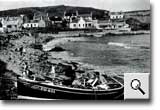 |
| |
|
|
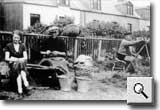 |
Traditional
long line fishing continued in Collieston into the
1950s. By the end of World War 2 there were very few
boats fishing full time, it was however still very
much a family affair.
A young female relative is seated next to Andrew John
Walker. He is preparing bait ready to lay it into
a wicker skull, two other skulls are sitting on the
fence behind him. The bait, either mussels, mackerel,
or lug worm is in the enamel plate on his knee. Another,
more elderly relative is seated working on a line
suspended from a tripod frame.
Behind the group is the row of two storey houses known
as Jubilee Terrace. The Walker’s shed with its
luxury of running water is to the left of Andrew John.
The dormer windows on the upper storey are the original
– they have subsequently been modernised.
|
| |
|
|
| |
|
|
| |
Forvie
becomes a National Nature Reserve |
|
| |
| |
The
Sands of Forvie looking south from Rockend circa 1950.
Forvie’s unique moorland, dune system and beaches
led to it being declared as one of Scotland’s
first National Nature Reserves in January 1959.
The salmon fishermen’s bothy at Rockend is clearly
visible in the foreground. The long established fishery
in nearby Newburgh was operational until the end of
the 20th century when declining stocks of wild salmon
meant that it was no longer commercially viable. Malcolm
Forbes, on behalf of the Cruden Bay Salmon Company,
last fished it in 1999. |
| |
|
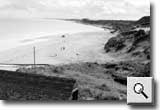 |
|
 |
|
| ....copyright
collieston's century 2003 |
|